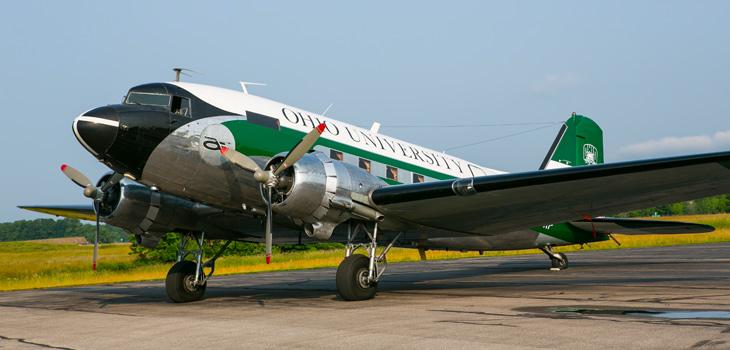
DC-3 Research Laboratory

This aircraft was delivered to the U.S. Army as a C- 47 on Oct. 7, 1943, (Serial No. 13896). By Nov. 22, 1943, it was delivered to Brisbane, Australia. There is no history of how it participated in the WWII Pacific Theater. The DC-3 was reported missing from inventory on Dec. 17, 1945, and emerged again in the United States in 1947. In October 1947, it was transferred to the Civil Aeronautics Administration (now the FAA) and converted to a DC- 3C, Registration N-7, for use as a flight check aircraft. For the next 29 years this aircraft served the FAA in the United States, to flight check and commission navaids and landing systems. In 1976, it was retired by the FAA and transferred as excess government property to Ohio University, Registration N7AP, to be used as a research laboratory for the Avionics Engineering Center. It continues as an avionics research laboratory today.
Specifications
- Type: Large, twin engine, unpressurized aircraft
- Year: 1943
- Engines: 2 x P&W R-1830-94 14 cylinder radials, 1350HP/ea
- Seats: Typically 4-10 in research configuration
- Dimensions: Wingspan 95', Length 64'6", Height 16'11"
- Maximum takeoff weight: 26,900 Lbs.
- Fuel capacity: 804 gallons
- Maximum speed: 262 mph.
- Cruise speed: 165 mph.
- Maximum altitude: >20,000'
- Maximum endurance: 8 hours
Research Equipment/Capabilities
- 19" equipment rack: 46.75" high, 24" deep
- 5 additional rack shelves available: 10.5" high, 18.5" wide, 26" deep
- 6' long workbench
- Electrical power available:
- 2 x 300A @ 28VDC generators (aircraft and equipment power source)
- 26.1A @ 115VAC, 60Hz
- 15A @ 115VAC, 400Hz
Research Antennas Available
- VHF
- Radar altimeter
- Glideslope
- Nav/Com
- L-Band
- GPS, 9 total antennas
Multiple Additional Antenna Pads Available
- Honeywell HG-1150 navigation grade inertial reference unit
- Two large reinforced fuselage areas with removable skin sections on bottom of aircraft. Typically used to airborne optical equipment.
In recent years, N7AP has performed flight evaluations and measurements for ILS, MLS, RFI, VOR, GPS, DGPS, ALS, as well as other studies for the FAA, NASA, and additional sponsoring agencies.